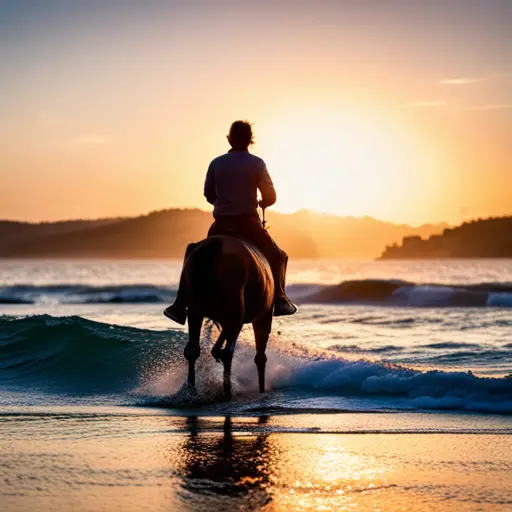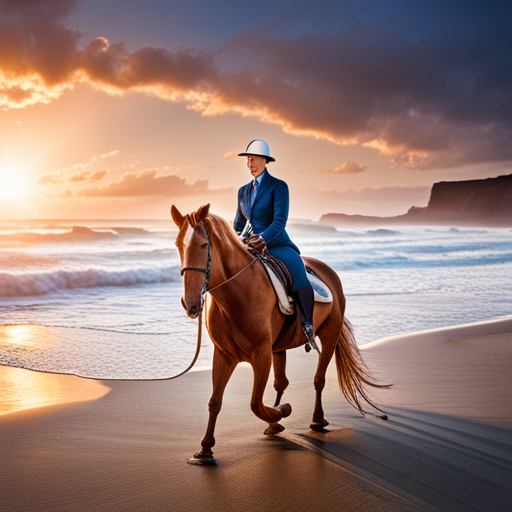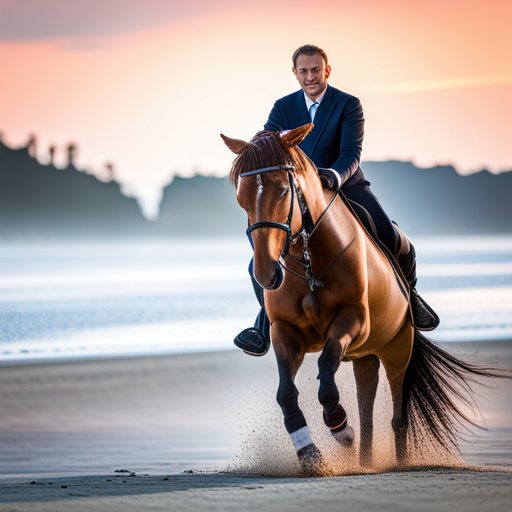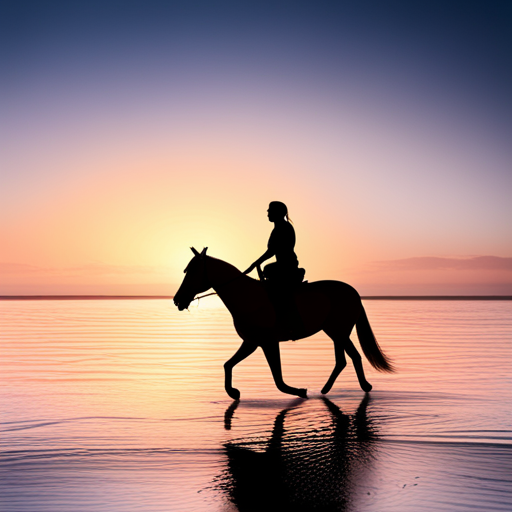Are you ready to unleash your spirit and experience the freedom of horseback riding on the beach? There’s nothing quite like the rush of wind in your hair and the pounding of hooves on the sand as you gallop along the shoreline.
But before you saddle up, it’s important to be prepared with the right skills and knowledge to ensure a safe and enjoyable ride.
So get ready to embrace your inner wild spirit and let the beach be your playground as you embark on an unforgettable horseback riding experience.

Key Takeaways
– Preparation is key for a safe and enjoyable beach ride, including choosing a suitable horse, wearing appropriate clothing and bringing necessary equipment.
– Proper riding techniques, such as maintaining correct posture and effective communication with the horse, are crucial for safety and comfort.
– Equipment maintenance, weather considerations, and building trust with the horse are also important factors to consider before and during the ride.
– Post-ride care and respect for the horse and environment, including showing gratitude to the horse, taking care of the horse, and leaving the area as found, are essential for a positive experience.
Horseback Riding On The Beach Practical Guide – Some Key Focus Tips
In this practical guide, you’ll learn everything you need to know to make the most of your beach riding adventure. From choosing the right horse to mastering mounting and riding techniques, we’ll guide you through each step of the process.
Choose the Right Horse

You’ll need to pick the perfect horse to ride on the beach, so make sure you’re looking for one that’s calm and comfortable in the sand.
A horse’s temperament is crucial in determining whether it’s suitable for beach riding. You’ll want to find a horse that’s not easily startled or spooked by the sound of waves crashing, wind blowing, or other beachgoers. Look for a horse that’s confident and composed, able to navigate through uneven terrain without getting nervous or agitated.
In addition to temperament, consider your own riding experience when selecting a horse. If you’re an experienced rider, you may prefer a horse with more energy and spirit, while a beginner may want a more laid-back horse.
Make sure you communicate your riding level to the stable or instructor, so they can match you with a horse that’s appropriate for your skill level. Remember, the right horse can make all the difference in having a safe and enjoyable beach riding experience.
Prepare for Your Ride

Before embarking on your horseback riding adventure, it’s important to prepare for your ride.
Dress appropriately for the occasion, wearing comfortable, fitted clothing and sturdy boots with a heel.
Don’t forget to bring necessary equipment such as a helmet, sunscreen, and water bottle.
Additionally, understanding safety precautions like how to properly mount and dismount your horse and how to properly control your horse will ensure a safe and enjoyable experience.
Dress Appropriately
Proper attire is crucial when horseback riding on the beach, so make sure to wear comfortable clothes and sturdy shoes. As the old adage goes, ‘dress for success,’ and that includes dressing appropriately for your beach riding adventure. When it comes to beachwear essentials, think about wearing lightweight, breathable fabrics that won’t weigh you down or cause you to overheat. Stay away from heavy fabrics like denim, which can chafe your skin and restrict your movement. Opt for shorts or leggings instead, and wear a comfortable top that won’t get in your way while you’re riding.
Additionally, it’s important to consider the weather when choosing your riding attire. If it’s sunny, be sure to wear a hat and apply sunscreen to protect your skin from harmful UV rays. If it’s cooler or windy, consider wearing layers that you can easily remove if you start to overheat. And always make sure to wear closed-toe shoes with a sturdy sole, as this will provide protection for your feet and a secure grip in the stirrups. With the right attire, you’ll be able to fully enjoy your horseback riding adventure on the beach.
| Clothing | Footwear |
|---|---|
| ——– | ——– |
| Light-colored, breathable fabrics | Closed-toe shoes with sturdy sole |
| Shorts or leggings | Avoid sandals or slip-on shoes |
| Comfortable top | Wear boots with a low heel for added stability |
| Hat and sunscreen for sunny weather | |
| Layers for cooler or windy weather | Bring a rain jacket or poncho in case of rain. |
Bring Necessary Equipment
Don’t forget to pack the necessary equipment for your beach ride, including a helmet, water bottle, and any personal medication. Horseback riding on the beach can be a thrilling and liberating experience, but it’s important to be prepared. Make sure your helmet fits properly and is in good condition. You never know when accidents can happen, so it’s better to be safe than sorry.
Also, bring a water bottle to stay hydrated during your ride. The sun and saltwater can quickly dehydrate you, so it’s important to drink plenty of water. If you have any personal medication, make sure to bring it with you in case of emergencies.
It’s also important to consider equipment maintenance when packing for your beach ride. If you’re bringing your own horse, make sure their tack and equipment are in good condition and well-maintained. If you’re renting a horse, check with the rental company to see if they provide all necessary equipment or if there are any additional fees for renting gear. Some companies may offer package deals that include all necessary equipment for a set price, so it’s worth looking into.
Remember, the better the equipment, the safer and more enjoyable your ride will be.
Understand Safety Precautions
To ensure your safety while horseback riding on the beach, it’s important that you understand and follow all necessary precautions. Beach riding risks are unique and can pose a danger to both you and your horse. Here are some important safety precautions to keep in mind:
1. Always wear a helmet: Head injuries can be life-threatening, so make sure to wear a properly fitting helmet at all times while horseback riding on the beach.
2. Use appropriate safety gear: In addition to a helmet, you should also wear appropriate footwear with a heel and full-length pants to protect your legs from the stirrup and sand. Additionally, gloves can help you maintain a better grip on the reins.
3. Choose a well-trained horse: Not all horses are suited for beach riding, so make sure to choose a horse that is well-trained, calm, and comfortable in this environment.
4. Follow riding guidelines: Always follow the guidelines set by the stable or guide, such as staying in designated areas, maintaining a safe distance from other riders, and avoiding dangerous areas like rocky outcroppings or deep water.
By following these precautions, you can help ensure a safe and enjoyable horseback riding experience on the beach.
Mounting and Riding Techniques

When it comes to horseback riding, proper mounting and riding techniques are essential for a safe and enjoyable experience. Before you even swing your leg over the saddle, make sure you know the correct way to mount your horse.
Once you’re in the saddle, focus on maintaining a correct riding posture and communicating effectively with your horse to ensure a smooth ride.
Mounting the Horse
As you approach your majestic steed, you feel a sense of excitement and anticipation rising within you. Proper mounting techniques are crucial to ensure a safe and enjoyable ride on the beach.
Start by standing on the left side of the horse, facing the same direction as the horse’s head. Hold the reins in your left hand and the stirrup in your right hand. Place your left foot in the stirrup and push yourself up, swinging your right leg over the horse’s back.
As you sit in the saddle, adjust the stirrups to the proper length and hold the reins with both hands.
If you’re new to horseback riding or have had a negative experience in the past, it’s common to feel anxious about mounting the horse. However, it’s important to remember that horses are sensitive animals and can sense your emotions.
Take deep breaths, relax your body, and focus on the present moment. You can also ask your guide or instructor for assistance or support if needed.
With practice and patience, you can overcome your mounting fears and fully enjoy the freedom and beauty of horseback riding on the beach.
Correct Riding Posture
Get ready to saddle up and ride with killer posture that’ll have you feeling like a pro in no time. Correct riding posture is crucial for your overall safety and comfort while horseback riding. Here are some tips to help:
– Keep your head up and eyes forward to maintain balance and awareness of your surroundings.
– Relax your shoulders and arms, letting them hang naturally by your sides.
– Sit up straight, engaging your core muscles to support your back and maintain balance.
– Keep your heels down and toes pointed forward, with your feet parallel to the horse’s sides.
It’s important to avoid common mistakes that can compromise your correct riding posture. Avoid slouching or leaning forward, as this can throw off your balance and put unnecessary strain on your back.
Additionally, avoid gripping the reins too tightly or using them to balance yourself, as this can lead to an awkward posture and discomfort for both you and the horse.
With these tips in mind, you’ll be well on your way to a comfortable and safe ride.
Communication with the Horse
Communication with your horse is like engaging in a silent conversation, where your body language and movements are the words. Understanding your horse’s body language is key to building a bond and trust between you and your equine partner.
Horses communicate with each other through body language, and they read our body language too. They’re sensitive animals that can pick up on our emotions and feelings, so it’s essential to stay calm and relaxed when riding.
Building trust with your horse involves understanding their cues and responding appropriately. For example, if your horse is nervous or scared, they may tense up and become rigid. As their rider, it’s your job to reassure them and provide a calming influence.
Similarly, if your horse is feeling playful or energetic, you can encourage them with your body language, allowing for a fun and exciting ride. By communicating effectively with your horse, you can create a harmonious partnership that allows for a safe and enjoyable experience.
Enjoy the Beach Ride

You’ll absolutely love feeling the wind in your hair and the saltwater mist on your face as you gallop along the beach on horseback, but have you thought about packing sunscreen and a hat to protect yourself from the sun’s harmful rays? As you embark on this exhilarating adventure, it’s important to take precautions to ensure you have a safe and enjoyable experience. Here are some tips to help you make the most of your beach ride:
– Safety first: Always wear a helmet and proper riding boots to protect your head and feet. Make sure your horse is well-trained and responsive to your commands.
– Pack the essentials: Bring sunscreen, a hat, sunglasses, and a bottle of water to stay hydrated. Don’t forget to bring a camera to capture the breathtaking views and memories of your ride.
Beach riding offers numerous benefits, including the ability to connect with nature, enjoy the fresh air and exercise, and bond with your horse. Some of the best beaches for horseback riding include Cape Cod in Massachusetts, Waikiki Beach in Hawaii, and Assateague Island in Maryland.
By following these tips, you’ll be able to fully enjoy the experience and create memories that will last a lifetime. So, what are you waiting for? Get ready to unleash your spirit and ride off into the sunset.
After the Ride

Once your beach ride has come to an end, it’s important to show gratitude to your horse for the incredible experience. Take a moment to dismount and thank your equine friend by giving them a pat or a gentle rub. This not only shows appreciation for the horse’s hard work, but also helps to build trust and strengthen the bond between you both.
After thanking your horse, it’s time to take care of them. Give your horse a good rub down to help them cool down and dry off. Take off their saddle and bridle, and offer them some water to rehydrate. It’s important to also check their hooves for any debris that may have gotten lodged during the ride, and to give them a quick brush to remove any dirt or sweat.
Remember to always respect your horse and the beach horseback riding community by leaving the area as you found it, disposing of any trash properly and showing respect to fellow riders.
Frequently Asked Questions
What types of clothing and footwear are recommended for horseback riding on the beach?
For a comfortable ride, wear clothing that is light and breathable. Long pants and closed-toe shoes with a low heel are recommended. Consider bringing a hat and sunglasses to protect from the sun. Choose gear that is appropriate for beach conditions.
Are there any age or weight restrictions for participating in a beach horseback riding experience?
Before you hit the beach on horseback, it’s important to consider age and weight restrictions. Most stables have guidelines for safety reasons. Additionally, practical tips for attire can make your experience more enjoyable.
How long does a typical beach horseback riding excursion last?
Typical beach horseback riding excursions last anywhere from 1 to 2 hours, depending on the package you choose. Pricing considerations vary based on duration expectations, but most tours offer affordable options. Get ready to unleash your spirit and enjoy the freedom of riding on the beach!
Are there any safety precautions or guidelines that riders should be aware of before embarking on a beach ride?
Beware of Beach ride safety and Horse behavior. Before embarking on a ride, wear appropriate clothing and footwear. Listen to your guide’s instructions, respect the horse’s space, and avoid sudden movements.
What types of scenery or wildlife can riders expect to encounter during their beach horseback riding adventure?
During your beach riding adventure, you can expect to witness breathtaking scenery such as the vast ocean and sandy shores. As for wildlife encounters, keep an eye out for seabirds, dolphins, and even the occasional seal.
Conclusion
Congratulations! You’ve successfully completed your beach horseback ride.
As you dismount and look back at the trail of hoofprints left behind, you may feel a sense of accomplishment and freedom. That’s because riding a horse on the beach is more than just a fun activity – it’s a symbol of strength and harmony between human and animal.
The horse, with its majestic presence and powerful gait, represents freedom and wildness. As you ride along the shoreline, the waves crashing against the shore and the wind in your hair, it’s easy to feel the same sense of liberation as the horse beneath you.
But it’s important to remember that this freedom comes with responsibility. Respect the horse’s boundaries and needs, and it’ll reward you with a magical experience that’ll stay with you forever.
So, next time you feel the urge to break free from the monotony of everyday life, consider a beach horseback ride. With the right preparation, a suitable horse, and a humble attitude, you can unleash your spirit and connect with the natural world in a way that few other activities can offer.
Embrace the adventure, and let the horse show you the way.

